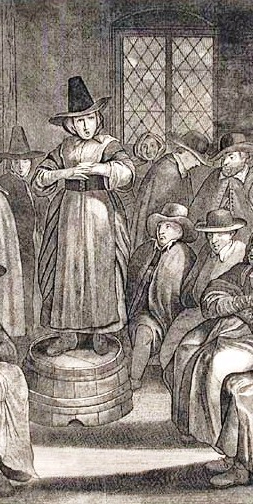This is fascinating for me, but may not be to anybody else as there is no explicit forum-relevant content -- please ignore unless you're following me down the wormhole of my Doris Ritter obsession.
I have previously posted a map and description of the locality relevant to the story:
There aren't that many sources about the actual punishment. The most authoritative, and most contemporaneous, is the King's actual order quoted above. That makes no mention of stripping but does mention two very locatable places of whipping (the town hall and her father's house), plus the rather vague "then at all corners of the Town". I know exactly where the Town Hall and Doris's home were located on an old map of Potsdam, only about 50m from each other. The Town Hall was (and still is) on the east side of the Alter Markt, whereas Doris's father had lodgings in the four-story school building adjuncted to St. Nicolai Church, located right to the East of the Church. Here is an old map of the time:
View attachment 878257
The Town Hall is marked "Rathaus", and is the red building at the east of the market square, i.e. south east of the church. Doris and her Family lived on the top floor of the school, which is the red building directly east of the church (red demarks buildings of four stories or higher). The Royal Palace was also directly opposite, the large red building at the south west of the market square (now the State Parliament of Brandenburg). All very cosy and near to each other -- Potsdam was then a very small town recently transformed into a combination of royal residence and military garrison, with all these buildings having been built in the previous five years after the King relocated his court from unruly Berlin. The Prince got to know Doris when he heard her sing during a church service at St Nikolai (where her father was cantor, i.e. director of the church music, a post that was combined with that of running the affiliated grammar school), a short stroll from the Palace, and then on the spur of a moment followed her to her lodgings and knocked at the door. All this happened in this little market square.
So, we had a first whipping outside the town hall, then she was dragged to the next block and whipped again outside the school building where her family's lodgings were. Nobody knows in detail what happened thereafter when she was whipped at "all corners of the Town". Several sources say with confidence that there were another four whippings, but as far as I can see that is simply based on the fact that Potsdam at the time had a broadly rectangular outline, and interpreting the "corners of the Town" as the corners of that rectangle. The alternative would be to think that they were street corners, but even in 1730, Potsdam had a few dozen crossroads which is unworkable even if the King's malice may have liked that. Voltaire's description sounds like a humiliating circuit of the entire town, maybe something like a whipping at the cart's tail. I'm still trying to decide what option to go for in my fictionalisation (if I ever get around to it). Either way, at the end of that ordeal she was brought to Spandau for incarceration. That may have been by cart, but it may have been easier dumping her on a boat going down the River Havel which connects both towns.
So, the four main buildings relevant to this story were all arranged around a single square, the Alter Markt (Old Market) in Potsdam:
- The Stadtschloss (Town Palace), where the Crown Prince and the King lived.
- The Church of St. Nikolai, Potsdam's main Lutheran church, where Doris's father held the post of cantor (master of the church music) and organist. This is where the prince first saw Doris when she was singing the solo soprano in mass, under her father's direction.
- The school house affiliated to St. Nikolai, where Doris's family lived and her father held the post of rector (which was part of the cantor position). This is where the Crown Prince first met Doris, where he visited on a near-daily basis in Spring 1730 for joint music-making. This is also where Doris received her second whipping, clearly a deliberate measure by the King to maximise her (and by proxy his son's) exposure and humiliation.
- The Town Hall, where Doris was taken after her arrest on 1 September 1730, where she was interrogated by two army officers (a Leutnant and a Fähnrich), where she was held for seven days, and where she then received her first public whipping.
All conveniently located within a hundred metres or so from each other, and all shown in great detail in three wonderful paintings by Karl Christian Wilhelm Baron which show the Alter Markt from three different angles. They were commissioned in 1771 by Friedrich II (the former Crown Prince, Doris's maybe-lover) to show off his new building work in the centre of Potsdam, and all three are available at
Wikimedia (from the website of the palace of Sancoussi) in exceptionally high resolution. I am uploading them in lower resolution here, but have also clipped and magnified some interesting details, as Baron has included some street scenes which help visualising how the populace may have reacted to the whipping. Because of the new building work in the forty years since 1730, it doesn't look quite the same as during Doris's time, but the layout is the same and no doubt the street scenes would have been broadly similar.
The first painting is the view onto the church of St. Nikolai:

We see the corner of the palace on the left side of the picture. On the right side, we have the Town Hall (with the peculiar tower). The school house (Doris's home) is in the street between church and Town Hall, the sligthly-higher building opposite the church, i.e. two houses along from the Town Hall. Not a long distance for Doris to be dragged between the first and second whippings. The Town Hall and the school were both re-built in the 1750s, but they occupy the same plot as their predecessor buildings (which themselves had been built only in 1725, i.e. were only five years old in 1730, but the old King was famously tight with money and the buildings therefore a bit shoddy). The palace and the church are still the same buildings as in 1730 (the church was also built in 1725, the palace about hundred years earlier), but the church had a new and ill-fitting rococo entrance added in the 1750s. The obelisk is also from the 1750s (and still there now). The church burned down in 1795 and was replaced by a much grander classicist church now occupying the space.
The second painting shows the same square but this time with a view along the front of the palace:

Palace to the left, church of St. Nikolai to the right.
Finally, we also get a view onto the Town Hall:

Church on the left, Town Hall in the centre, the view onto the school is obscured by the church building and we see only the house between school and Town Hall.
The street scenes show that despite this being the grand ceremonial heart of the kingdom (still a very minor state in 1730, although somewhat grander by 1771), this was very much still a functioning, busy and ribald market square, with lots of market stalls and various street amusements. Thus, a ready source for a crowd of onlookers to gather to gawk at the spectacle of a young girl being whipped for involvement in the big scandal of the day, the attempted desertion and arrest of the Crown Prince by his own father. As this was a major garrison town, and Prussia a thoroughly militarised state, we do get to see a lot of military personnel in uniform on the streets.
I can't see a
Schandpfahl (whipping post) or a fixed public
pranger (pillory) in front of the Town Hall. However, there does appear to be a form of public shaming in a type of pillory going on just about where Doris's first whipping would have taken place:

This appears to be a man forced to stand in a "Spanischer Mantel", a form of cangue made out of a barrel with a cutout for the neck in the lid. There is a platoon of soldiers with guns around him, and a desultory number of not-very-interested onlookers -- clearly not much fun watching a man being humiliated by standing in a wooden barrel. Not like a good old whipping... A much larger crowd has gathered at the other side of the square, where some sort of spectacle is taking place but we can't make out what. Several carts in the crowd, possibly with women on them, but too indistinct to tell:

The other pictures have intriguing crowd scenes as well. Here is a fight between three market wives in the second painting, upending a stall and a basket of eggs with various bailiffs with sticks ineffectively trying to break up the fight. I suspect these women may spend some time in these double neck fiddles specifically designed for quarrelling market wives (do they make them in a three-women-version?):

Finally, we have this very strange scene going on in front of the Town Hall in the first painting. There is a ring of two rows of soldiers with guns and fixed bayonets, some with royal flags. Outside the ring of soldiers, there are a fair number of onlookers, mainly women. Inside the ring, there are three figures: two in plain dress holding sticks or guns diagonally across their bodies, and the third dressed in white in a very dramatic posture, with a pistol in one hand firing down into the ground. What on earth is going on? Some sort of circus spectacle, or a public execution?:























